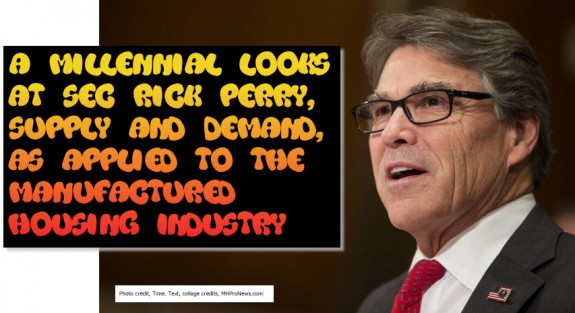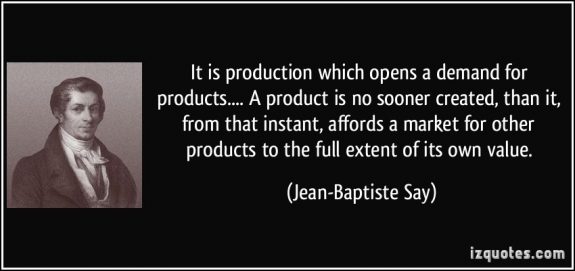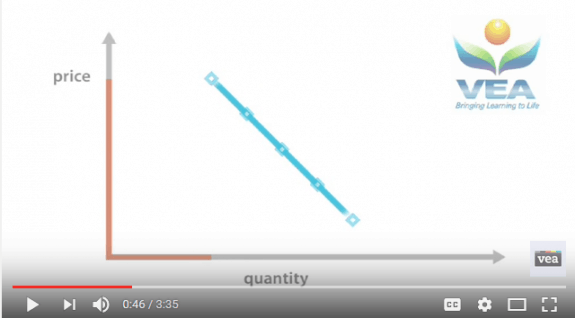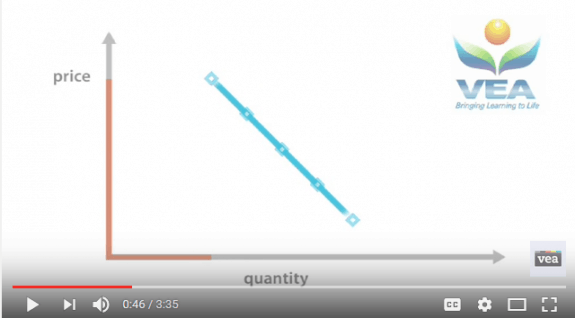
The reply was made by Perry after he had been subject to criticism in the media – with headlines such as:
- “Another ‘Oops’ Moment?”
- “Rick Perry Hilariously Misunderstands Supply and Demand Theory,”
- and more.
However, as an article in TownHall, pointed out, Perry’s “theory” was generally accepted by economists, even if it was well over a century ago.
“A product is no sooner created, than it, from that instant, affords a market for other products to the full extent of its own value,” – Jean-Baptiste Say, the French economist, in “A Treatise on Political Economy”
Understanding supply and demand is important, especially when industry professionals are seeing it directly affect the factory-built housing market.
For example, a higher demand for affordable housing has led to a shortage of that in many markets nationwide. That has boosted manufactured home sales by double-digits growth rates. While more is possible, say industry experts, even without that extra effort, the growth from demand is there.

Supply and Demand in Charts and Video
VEA Australia produced the video below, which demonstrates a basic understanding of the law of supply and demand.
The law of supply and demand, defined simply, is that when the price of a product or service falls, people will buy more of it – and more often.
However, following that same logic, when the price of that product or service rises, the demand for it falls along with that price hike. That drop-in demand continues as the price continues to increase, slowly reducing the amount that is demanded.

This – it should be noted – is why the NAHB “Priced Out” study makes sense.
Ironically, The Law of Supply and Demand is also why the Manufactured Housing Institute’s (MHI) original position was on the proposed DOE rule was flawed, and why the Manufactured Housing Association for Regulatory Reform (MHARR) position opposing the DOE regulations that MHI originally supported was the common sense one, representing the greatest good for the majority of the industry.

Price Alone Isn’t the Only Factor
On the other hand, price is not the only factor that reflects the demand for any one product or service.
One also has to take into consideration changes to
- population,
- income,
- and consumer preferences
– which can increase and decrease the demand depending on whether they are rising or falling.

For example, in the factory-built housing industry, the demand for affordable housing is high – due to increased populations, fewer jobs and lower-income levels there are fewer workers in various occupations.
Unfortunately, consumer preference presently tends to work against the industry for various reasons, including the misconceptions, stigma and stereotyping of manufactured housing.
Right now, the factory-built housing sector and affordable housing both fall into the same category on the supply and demand chain – shortage.
There is a very high demand for affordable housing – but because the price of traditional housing (the consumer preference) is so high, it does not fit the current demand.
The solution is a more affordable type of housing, like manufactured, modular and prefabricated housing, which is lower in price and can fill that shortage gap.

Not only would more people be able to buy a home, but since they will be able to reasonably afford the home, they will be able to spend more in other areas. That will lead over time lead to an increase in demand for many other products and services.
Eventually, if people would turn to manufactured housing to end the shortage of affordable homes, the supply and demand could reach an equilibrium – and from there we would see economic improvements among all income-brackets. This would lead to more economic freedom for individuals who earn low wages and cannot afford to live on that income in the current economy.
Secretary Perry’s Timely Comments
While Perry’s comments may seem misconstrued to some, the idea is that with more of something available, there will be an opportunity for a higher demand. That’s true for energy, and it is also true for housing.
Not everyone who owns a manufactured home is in the low-income, or even the middle-income bracket. The demand for manufactured housing will grow in all income and age brackets – once we see a change in consumer understanding and thus consumer preferences.

Educational efforts by innovators like New Durham Estates has proven that the proper information, presentation (education), combined with demand will lead to a surge in sales.
It all tends to go back to erasing the stigma that has dogged manufactured homes due to improper terminology, prejudice and stereotypes of decades long past.
Change the consumer preference – and we have the means to fill the supply shortage in this time when affordable homes are in the highest demand. ## (News, analysis.)
(Image credits are as shown above, and when provided by third parties, are shared under fair use guidelines.)


























